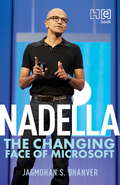- Table View
- List View
Nachhaltigkeit und Wirtschaftsrecht (Springer-Lehrbuch)
by Anne-Christin Mittwoch Anne SandersNachhaltigkeit ist eines der zentralen Themen unserer Gegenwart. Entsprechend wird auch die Rolle des Rechts zur Förderung von Nachhaltigkeit immer mehr diskutiert. Dieses Open Access Lehrbuch stellt die Nachhaltigkeitsthemen im Wirtschaftsrecht mit Bezug zu den jeweiligen rechtlichen und nichtrechtlichen Grundlagen verständlich dar und bietet so eine reichhaltige Informationsquelle für Studium, Wissenschaft und Praxis.
Nachhaltigkeit und organisationales Lernen
by Regina LülfsDie Umsetzung des gesellschaftlichen Leitbildes der Nachhaltigkeit erfordert Lernprozesse auch auf unternehmerischer Ebene. Regina Lülfs setzt sich mit diesen unternehmerischen Lernprozessen auseinander und untersucht deren Einflussgrößen. Sie greift dabei insbesondere auch auf psychologische und soziologische Erkenntnisse zurück und integriert so konzeptionell individuelle und kollektive Prozesse nachhaltigkeitsbezogenen organisationalen Lernens.
Nachhaltigkeit – es braucht Zeit, die doch drängt: Reformen – Wege nachhaltigen Wirtschaftens
by Hans-Michael FerdinandUnternehmen stehen in einem Zwiespalt, wenn es um nachhaltiges Wirtschaften geht. Analysen zeigen, dass eine nachhaltige Entwicklung der Erde dringlich ist, eigentlich keinen Zeitaufschub zulässt. Sie ist eine moralische Verpflichtung, die freilich in der Geschichte, unter geschichtlichen Bedingungen umzusetzen ist, in denen Menschen ihre berechtigten, oft unterschiedlichen Interessen und Wertvorstellungen vorbringen und im Unternehmenshandeln umgesetzt sehen wollen. Wie Unternehmen mit dem gesellschaftlichen Dilemma umgehen, einerseits an der nachhaltigen Entwicklung des Planeten mitwirken zu sollen und andererseits zugleich die Interessen aller Stakeholder zu berücksichtigen, ist Gegenstand dieser Untersuchung. Zunächst wird ein globaler Status Quo in Sachen nachhaltiger Entwicklung der Erde erhoben. Grundlage dafür sind wissenschaftliche Analysen zu Erderwärmung und Klimawandel, sowie zu Verfügbarkeit und gerechter Verteilung von Ressourcen. Und obwohl deren Ergebnisse dringliches Handeln verlangen, zeigen sich in Politik und Ökonomie immer wieder Hemmschuhe der Transformation, die zu überwinden sind. Der eine nicht: Nachhaltiges Handeln kann – zumal in demokratischen Gesellschaften – nicht von wem und was auch immer „verordnet&“, sondern um der Menschen willen nur durch beständige Reformen umgesetzt werden. Die wirtschaftsphilosophischen Ansatzpunkte dafür liefert Immanuel Kant. Für das nachhaltige Wirtschaften von Unternehmen werden daraus Meilensteine möglicher unternehmensindividueller Reformwege zusammengestellt, vor allem aus den Bereichen Beteiligung von Stakeholdern, Kreislaufwirtschaft, Klimaneutralität und menschenrechtlicher Sorgfalt. Mit deren Hilfe soll dann eine wissenschaftlich fundierte, empirische Content-Analyse von Nachhaltigkeitsberichten zeigen, wie deutsche Unternehmen unterschiedlicher Größenordnungen und Branchen mit der Entwicklung und Optimierung nachhaltiger Erträge umgehen. Daraus ergibt sich ein Bild nachhaltigen Wirtschaftens in Unternehmen, dessen Status Quo im abschließenden Kapitel zusammengefasst wird.
Nachhaltigkeit, Postwachstum, Transformation: Eine Rekonstruktion wesentlicher Arenen und Narrative des globalen Nachhaltigkeits- und Transformationsdiskurses
by Ulrich RoosDer Band versammelt zentrale Befunde abgeschlossener Forschungsarbeiten zur Frage der Entwicklung des globalen Nachhaltigkeitsdiskurses. Welche Narrative, Strategien, Ziele und Werte bestimmen den Kampf um Definition und Ausgestaltung nachhaltiger Politik? Welche Transformationsprozesse sind erkennbar, werden initiiert, gefordert oder bekämpft? Und welche Bedeutung kommt hierbei wirtschaftswissenschaftlichen Konzepten zu Wirkung und Relevanz von Wirtschaftswachstum sowie den hieran geäußerten Kritiken zu?Um diese Fragen zu beantworten, werden verschiedene Arenen des deutschsprachigen Nachhaltigkeitsdiskurses – Arbeit, Bildung, „Entwicklung“, Ethik, Transformation – detailliert rekonstruiert, um auf Grundlage der daraus resultierenden Gesamtschau des ökologisch-ökonomisch-politischen Systems die gegenwärtig hegemonialen Handlungsregeln und -logiken zu erkennen und kritisch zu reflektieren.
Nachhaltigkeit: Wegweiser für die Wirtschaft der Zukunft
by Katja MayerPrägnante und praxisorientierte Antworten zu Fragen rund um nachhaltige UnternehmensführungDieses Buch liefert 125 kurze und prägnant formulierte Antworten zu allen Themen rund um die operative und strategische Umsetzung einer nachhaltigen Unternehmensführung im Sinne international anerkannter Standards und aktueller Trends sowie der europäischen Anforderungen unter dem EU Climate Action Plan.Die erweiterten Berichtspflichten zur wirksamen und aussagekräftigen Ausgestaltung von Nachhaltigkeitsberichten treffen insbesondere große Unternehmen und indirekt deren Lieferanten und Partner. Nichtfinanzielle Kennzahlen zu Umwelt-, Arbeitnehmer- und Sozialbelangen, über die Achtung von Menschenrechten sowie die Bekämpfung von Korruption und Informationen die Diversität betreffend müssen in den Lage- und Konzernlageberichten aufgeführt werden. Dabei stellt die Berichterstattung keinen Selbstzweck dar. Vielmehr ist es die Aufforderung sich mit anstehenden Transformationsprozessen auseinanderzusetzen, ein umfassendes Risikomanagement zu etablieren, Chancen zu erkennen, an Robustheit zu gewinnen, Verantwortung zu übernehmen, Initiative zu zeigen und als Vorreiter wahrgenommen zu werden.Katja Mayers Buch schafft einen schnellen Überblick zu 10 Schwerpunktthemen; u. a. gibt die Autorin Impulse für Nachhaltigkeit als Treiber für Innovation und für einen gewinnbringenden Stakeholderdialog. Außerdem wird die besondere Rolle der Finanzmärkte hervorgehoben.Aus dem Inhalt Nachhaltigkeit aus UnternehmensperspektiveNachhaltige Unternehmensführung in Kern- und ManagementprozessenNachhaltigkeitskommunikation und Standards der BerichterstattungNachhaltigkeit aus Finanzmarkperspektive und die besondere Rolle von FinanzmarktakteurenNachhaltigkeit als Treiber für Innovationen und Stakeholder-EngagementNeu in der 2. Auflage Seit der Verabschiedung der Sustainable Development Goals im September und dem Pariser Klimaschutzabkommen im Dezember 2015 hat das Thema Nachhaltigkeit einen weiteren Entwicklungsschub erfahren. Die 2. Auflage des Buches spiegelt das in einer umfassenden Überarbeitung der ursprünglichen Themen und durch die Ergänzung um weitere 14 Fragen und Antworten wider. Es werden insbesondere die Neuheiten aus dem EU Action Plan und weitere internationaler Trends aufgegriffen. Darüber hinaus wird über die Print-Version ein kostenloser Zugang zu einem digitalen Frage- und Antwort-Set (Zugriff durch die Springer Nature Flashcards App) mit Fragen rund um nachhaltige Unternehmensführung bereitgestellt. Das Buch richtet sich an Praktiker und Experten aus Unternehmensbereichen wie Unternehmensführung, CSR, Finanzen, Investor Relations, Risikomanagement, Corporate Governance, Supply Chain Management, Einkauf, PR & Kommunikation sowie an alle, die sich für Nachhaltigkeit und Unternehmensführung interessieren.
Nachhaltigkeitsberichterstattung großer Unternehmen: Eine Analyse unter besonderer Berücksichtigung des Konzepts der New Corporate Governance (BestMasters)
by Julia ReimerDie ökologische und soziale Verantwortung von Unternehmen ist schon seit Jahrzehnten Thema der Weltpolitik. Die EU stärkte 2023 mit dem Inkrafttreten der Corporate Social Reporting Directive die Bedeutung der nicht-finanziellen Berichterstattung. Auch am Kapitalmarkt steigt das Interesse an nachhaltigen Unternehmen. Die ökonomische, ökologische und die soziale Dimension der unternehmerischen Nachhaltigkeit können jedoch nicht immer in Einklang gebracht werden. Die unternehmerische Realität ist durch Zielkonflikte zwischen den drei Dimensionen geprägt. Die Forschung konnte bisher kaum praktikable Lösungsansätze zum Umgang mit Zielkonflikten in der Praxis entwickeln. Das Konzept der New Corporate Governance könnte eine neue Perspektive bieten. Indem die Zielfunktion der Unternehmen um die sozialen Präferenzen der Shareholder und die externen Auswirkungen der Geschäftstätigkeit erweitert wird, entsteht ein neues Optimierungskalkül für Unternehmensleitung und Aktionäre. Um dabei fundierte Entscheidungen treffen zu können, müssen jedoch Informationen publiziert werden. Die Untersuchung ergründet, inwieweit die aktuelle Nachhaltigkeitsberichterstattungspraxis in Deutschland kompatibel mit den Informationsanforderungen ist, die im Rahmen der New Corporate Governance entstehen.
Nachhaltigkeitscontrolling: Instrumente und Kennzahlen für die strategische und operative Unternehmensführung (essentials)
by Wanja Wellbrock Daniela Ludin Sina KrauterDieses essentials beschreibt, wie Nachhaltigkeit im Unternehmen verankert werden kann. Es zeigt, welche explizite Rolle das Controlling hierbei einnimmt. Im Fokus steht die normative, strategische und operative Dimension des Nachhaltigkeitscontrollings. Ausgehend von einer klar definierten Nachhaltigkeitsvision im Unternehmen wird, unterstützend durch das Controlling, eine ganzheitliche Nachhaltigkeitsstrategie entwickelt, die anschließend im operativen Nachhaltigkeitscontrolling durch Einzelmaßnahmen umgesetzt und durch konkrete Kennzahlen messbar gemacht wird.
Nachhaltigkeitsklauseln für Mietverträge: Green-Lease-Verträge schnell und effektiv umsetzen
by Zulfukar TosunDieses Buch hilft umfangreich bei der Erstellung von Green-Lease-Mietvertragsklauseln. Es richtet sich hauptsächlich an Immobilieneigentümer und –verwalter,sowie an Fondmanager, Assetmanager, Portfoliomanager und Leasingmanager sowie Rechtsanwälte. Green Leases definieren die nachhaltigen Verpflichtungen zwischen Vermieter und Mieter im Bereich der EU-Taxonomieziele. Diese soll zu einem klimafreundlicheren Gebäudebetrieb führen. Die Ziele und Hintergründe werden ausführlich dargelegt. Die auf den jeweiligen Mietzweck maßgeschneiderte Mietvertragsklauseln bieten für den Mieter und den Vermieter praktische Umsetzbarkeit. Das Buch ist ein Leitfaden für die Immobilienbranche und berücksichtigt ebenfalls die Vorgaben der Zertifizierungen nach DGNB und BREEAM. Wie können Green Lease Verträge effektiv gestaltet werden? Welche Green Lease Klauseln haben Impact auf Ihre Immobilienfinanzierung? Welche Green Lease Klauseln können Sie für eine Gebäudezertifizierung nutzen? Basierend auf dem aktuellen Stand der Praxis bietet dieser Leitfaden für Wohnimmobilien und gewerbliche Mietverträge vorgefertigte Green Lease Klauseln mit Impact an. Der Autor gibt praxiserprobte Vorschläge für die Implementierung von Green Lease Klauseln in Mietverträgen und Nachträgen. Er zeigt anhand von 12 Fallbeispielen wie Mietverhältnisse zukunftssicher gemacht werden. Damit sparen Vermieter und Mieter Kosten und sorgen für Nachhaltigkeit der Immobilie.
Nachhaltigkeitskommunikation in der Gesundheitswirtschaft: Wie Sie nachhaltig agieren und glaubwürdig kommunizieren (Edition Nachhaltig wirtschaften)
by Viviane Scherenberg Tobias KestingDieses Buch beschäftigt sich mit der Innen- und Außenkommunikation „echter“ Nachhaltigkeit. Denn Kommunikation ist ein wichtiger Baustein, damit gelebte Nachhaltigkeit und nachhaltiges Handeln in der Praxis der Gesundheitswirtschaft funktionieren. Aus der Analyse verschiedener Ebenen (organisations-, produkt- und/oder prozessbezogen) und der Betrachtung unterschiedlicher Stakeholder-Perspektiven (insb. Patient*innen, Mitarbeitende, zukünftige Arbeitnehmer*innen und Gesellschaft) sowie unter Einbeziehung von Praxisbeispielen und Erkenntnissen aus Interviews zeigt das Autorenteam, wie nachhaltiges Handeln und dessen glaubwürdige Kommunikation in der Gesundheitswirtschaft umgesetzt werden können.
Nachhaltigkeitskommunikation in der Versicherungswirtschaft: Spielregeln, Erfolgsfaktoren, Trends (Essentials)
by Désirée Schubert Elsa PieperDésirée Schubert und Elsa Pieper zeigen in diesem essential auf, welchen eigenen Regeln Nachhaltigkeitskommunikation folgen sollte, um Wirksamkeit zu erzielen. Daraus haben die Autorinnen praxisrelevante Aspekte für die Versicherer übersetzt. Erfolgskriterien sind: Integrierte Kommunikation, Verständlichkeit, Wesentlichkeit und Glaubwürdigkeit sowie Dialogorientierung. Ausgewählte Beispiele zeigen, dass es sich lohnt, Nachhaltigkeit von Anfang an strategisch aufzusetzen und diese wirksam, d.h. in der richtigen Art und Weise über die richtigen Kanäle zu kommunizieren und mit relevanten Stakeholdern in den Dialog zu treten.
Nachhaltigkeitsmanagement - Handbuch für die Unternehmenspraxis: Gestaltung und Umsetzung von Nachhaltigkeit in kleinen und mittleren Betrieben (ifaa-Edition)
by ifaa – Institut für angewandte Arbeitswissenschaft e. V.Das Handbuch vermittelt in anschaulicher, praxisorientierter Weise Grundlagen, Inhalte und Vorgehensweise bei der Einführung und Verbesserung eines Nachhaltigkeitsmanagements in Unternehmen. Anhand von Beispielen wird einfach und verständlich dargestellt, wie Unternehmen durch die Gestaltung von Produkten, Unternehmensprozessen und Anlagen ihre Leistungsfähigkeit bei Umweltschutz, Wirtschaftlichkeit und Sozialverantwortung verbessern können. Das Handbuch befähigt die betrieblichen Akteure zur erfolgreichen Umsetzung in ihrem Betrieb. Das Handbuch enthält zudem Anregungen für Unternehmen, die integrierte Managementsysteme bspw. für Umwelt, Qualität und Nachhaltigkeit etablieren oder weiterentwickeln möchten.
Nachhaltigkeitsmanagement - Handbuch für die Unternehmenspraxis: Gestaltung und Umsetzung von Nachhaltigkeit in produzierenden Betrieben
by ifaa – Institut für angewandte Arbeitswissenschaft e. V.Das Handbuch vermittelt in kompakter Form die Grundlagen und ein praxisorientiertes Konzept zur erfolgreichen Einführung und Verbesserung eines Nachhaltigkeitsmanagements in Unternehmen. Es basiert auf einem ganzheitlichen Verständnis von Nachhaltigkeit, das neben wirtschaftlichen, umweltbezogenen und sozialen Aspekten auch technische Ziele berücksichtigt. Die Inhalte werden strukturiert, übersichtlich und anschaulich dargestellt. Das Handbuch enthält zudem zahlreiche Hinweise sowie praktische Arbeits- und Gestaltungshilfen für betriebliche Akteure.
Nachhaltigkeitsmanagement für Führungskräfte (essentials)
by Roland Pfennig Erik Müller-SchoppenDie Autoren dieses essential zeigen pointiert Grundlagen des Nachhaltigkeitsmanagements und der Individualpsychologie auf und schaffen damit Verständnis für wichtige, ein Nachhaltigkeitsmanagement fördernde Skills für Führungskräfte. Menschenkenntnis kann der Schlüssel sein für ein Sustainable Leadership Management. Bisher machen nur wenige Unternehmen ein ideologiefreies, echtes Nachhaltigkeitsmanagement vor – einige folgen, viele zeigen bislang noch keine Aktivitäten. Längst schon gibt es aber schlüssige wirtschaftliche und wissenschaftliche Ansätze, sich mit dem Thema auseinanderzusetzen – und es gibt gute Gründe dafür. Warum sind dennoch viele Unternehmen noch immer so reserviert? Die tieferen Gründe sind häufig nicht logisch, sondern „psycho-logisch“.
Nachhaltigkeitsmanagement im Gesundheitsbetrieb: Umsetzungsreife Konzepte für Klima- und Umweltschutz in Gesundheitseinrichtungen
by Andreas FrodlGesundheitsbetriebe sind gleichzeitig Betroffene und Mitverursachende des Klimawandels: Sie müssen Patient*innen, Bewohner*innen und Mitarbeitende vor dessen Auswirkungen schützen und gleichzeitig ihren Beitrag zum Umweltschutz leisten. Dieser Komplexität tragen die acht Leitfragen und daraus abgeleiteten Kapitel dieses Buches Rechnung.Als umfassende Anleitung zur Implementierung von Nachhaltigkeitsmanagement in Gesundheitseinrichtungen zeigt es, wie Klima- und Umweltschutz effektiv integriert werden können. Es behandelt die Herausforderungen und Chancen, Gesundheitsbetriebe nachhaltig auszurichten und bietet praxisnahe Lösungen zur Umsetzung. Zahlreiche Beispiele, Tabellen und Grafiken sowie konkrete Handlungsanleitungen und ein Glossar veranschaulichen und unterstützen diesen Ansatz.Für Führungskräfte, Nachhaltigkeitsbeauftragte und Entscheidungstragende im Gesundheitswesen, für Wissenschaftler*innen und alle, die die Zukunftsfähigkeit ihrer Einrichtungen nachhaltig sichern wollen.
Nachhaltigkeitsmanagement im Gesundheitswesen: Konzeptionelle Grundlagen und Orientierungshilfen (essentials)
by Matthias FischerDas Thema Nachhaltigkeitsmanagement gewinnt auch im Gesundheitssektor stark an Bedeutung. Nicht zuletzt, da auf Bundes- und europäischer Ebene neue rechtliche Anforderungen gestellt werden, die auch für viele Organisationen des Gesundheitswesens aktives Handeln in Richtung Nachhaltigkeit und Wahrnehmung der gesellschaftlichen Verantwortung erfordern.Dieses essential bietet Ihnen eine praxisnahe Einführung, durch die Sie sich eine Orientierung im Thema - eben mit spezifischem Fokus auf den Gesundheitsbereich - erarbeiten können. Es möchte bestehende Werke in diesem rasant wachsenden Feld nicht ersetzen, sondern um eine schnelle Orientierungshilfe ergänzen. Sie werden sowohl grundlegende Begrifflichkeiten und theoretische Hintergründe rund um das Thema Nachhaltigkeitsmanagement kennenlernen als auch Hilfestellungen zur Formulierung einer Nachhaltigkeitsstrategie oder zur Nachhaltigkeitsberichterstattung erhalten. Innerhalb kurzer Zeit können Sie sich so zunächst einen grundlegenden Überblick verschaffen und im Anschluss zum Aufbau eines Nachhaltigkeitsmanagements in Ihrer Organisation des Gesundheitswesens beitragen.
Nachhaltigkeitsmarketing: Eine fallstudienbasierte Einführung
by Kai-Michael Griese Karin SchnitkerDieses Buch führt in die Ziele, Strategien und Maßnahmen des Nachhaltigkeitsmarketings ein. Dabei werden ökonomische, ökologische und soziale Perspektiven berücksichtigt. Die Absicht ist, vor allem die Prinzipien und Merkmale des Nachhaltigkeitsmarketings stärker als Standard für alle Marketingaktivitäten zu verankern. Eine ausgewogene Mischung aus theoretischen Grundlagen und Fallbeispielen – wie Allos-Hofmanufaktur, dm-drogerie Markt, Initiative Tierwohl und Edeka Zentrale Stiftung & Co. KG, Migros, Molkerei Söbbeke, Pampers, Raizen Biosprit Produktion, Rügenwalder Mühle, Vaude, Waschbär, Weleda – machen das Buch sowohl für Studierende als auch für die unternehmerische Praxis interessant.Die 2. Auflage wurde vollständig überarbeitet und um zahlreiche Praxisbeispiele erweitert. Insbesondere wurden folgende Anpassungen vorgenommen: Integration der Sustainable Development Goals (SDG) als normativen Orientierungspunkt für die Ausgestaltung des Nachhaltigkeitsmarketings bis 2030Stärkere Berücksichtigung der normativen, strategischen und operativen ManagementebeneIntegration der Digitalisierung im Rahmen von digitalen Märkten, einer organisatorischen und instrumentellen Ebene (Technologien und Dienste)Zudem erhalten Sie Zusatzmaterial via App: Laden Sie die Springer Nature Flashcards-App herunter und nutzen Sie exklusive Inhalte, um Ihr Wissen zu überprüfen.
Nachhaltigkeitsorientierte Unternehmensführung: Employer Branding als Ansatz zur Gewinnung geeigneter Mitarbeiter (essentials)
by Kai WeinrichVor dem Hintergrund der aktuellen Nachhaltigkeitsdebatte beschreibt dieses Essential, warum Unternehmen zunehmend unter Druck stehen, Aspekte der Nachhaltigkeit im Rahmen ihrer Strategie zu berücksichtigen. In diesem Zusammenhang erläutert Kai Weinrich insbesondere die Bedeutung des Employer Brandings für die Gewinnung geeigneter Mitarbeiter, mit denen dieser Strategiewandel hin zu mehr Nachhaltigkeit möglich wird. Nachhaltigkeitstalente, die zusätzlich zu ihrer fachlichen Kompetenz nachhaltigen Fragestellungen eine hohe persönliche Bedeutung beimessen und somit für die nachhaltigkeitsorientierte Unternehmensführung von besonderer Bedeutung sind, können durch eine entsprechende Gestaltung der Employer Brand gezielt angesprochen werden.
Nachhaltigkeitsreporting für Finanzdienstleister
by Bernhard Colsman Meike FreseDieser Band der "Edition Bankmagazin" ist ein praxisorientierter Leitfaden zum Nachhaltigkeitsreporting in Finanzdienstleistungsunternehmen. Schwerpunkte des Werks sind die Bedeutung eines unternehmerischen Nachhaltigkeitsmanagements als Grundlage belastbarer Kommunikation, die Besonderheiten von Reporting in Banken und Versicherungsunternehmen, ein Überblick über relevante Frameworks für die Berichterstattung sowie ein ausführlicher Blick auf die Zukunftstrends von Berichterstattung zu nicht-finanziellen Aspekten der Geschäftstätigkeit.Berichterstatter finden hier die nötigen Fakten und Entscheidungskriterien, um ein effektives Reporting auf- oder auszubauen, das individuell auf ihr Unternehmen zugeschnitten ist. Schritt für Schritt wird erläutert, worauf es bei der Erstellung eines Berichts ankommt und was die Stellschrauben für Effizienz und Wirksamkeit sind. Zahlreiche Praxistipps und Fallbeispiele von Banken und Versicherern erleichtern dabei die Umsetzung und bieten Denkanstöße für die individuelle Skalierung und Ausrichtung von Berichterstattung und Kommunikation.
Nachhaltigkeitsstandards in der Kreditvergabe im Firmenkundengeschäft: Überblick, Einordnung und Bewertung der aufsichtsrechtlichen Anforderungen (essentials)
by Hans-Christian Brauweiler Christian BergerDieses essential gibt Entscheidungsträgern Hilfestellung zu Nachhaltigkeitsrisiken bei Krediten. Die Anforderungen der Bankenaufsicht an das Management dieser Risiken werden ebenfalls betrachtet.Die EU verfolgt das Ziel, bis 2050 der erste klimaneutrale Kontinent zu werden. Hierfür beschloss die EU Regulierungen zur Transformation der Wirtschaft. Für die erforderlichen Finanzmittel reichen öffentliche Gelder nicht aus, weshalb auch Unternehmensinvestitionen notwendig sind. Kreditinstituten fällt es zu, Nachhaltigkeitsrisiken im Kreditgeschäft zu berücksichtigen.
Nachhaltigkeitstransformationen erfolgreich initiieren und gestalten: Psychologische Perspektiven und Handlungsempfehlungen für Manager:innen (essentials)
by Paula Maria BögelDie aktuellen Geschehnisse zeigen, dass eine rasche und entschiedene Wende hin zu einer nachhaltigen Entwicklung unumgänglich ist, wenn wir uns und unseren Planeten retten wollen. Gerade Unternehmen können hier einen großen Beitrag leisten. Trotzdem kommen wir oft nicht ins Handeln oder es fehlen die Mitstreiter:innen im Unternehmen. Das essential stellt die wichtigsten Strategien für eine erfolgreiche Veränderung hin zu mehr Nachhaltigkeit vor und zeigt, wie Mitstreiter:innen für diese Transformation gewonnen werden. Es geht konkret der Frage nach, was wir aus der Psychologie für die Nachhaltigkeitstransformation lernen können. So werden psychologische Theorien verständlich vorgestellt, inspirierende Fallbeispiele gezeigt und konkrete Impulse für die Umsetzung im eigenen Unternehmen (und privatem Umfeld) gegeben.
Nachhaltigkeitswissenschaften
by Harald Heinrichs and Gerd MichelsenForscher und Dozenten der ersten deutschen Fakultät für Nachhaltigkeitswissenschaften an der Universität Lüneburg haben das Standardwerk zum Thema geschrieben. Sie schildern zunächst die naturwissenschaftlich-technischen Grundlagen, um anschließend die Perspektive der Akteure und integrierende Ansätze darzustellen. Zuletzt werden beispielhaft Problem- und Handlungsfelder wie Biodiversität und globale Gerechtigkeit aufgezeigt. Mit Infokästen, illustrativen Fallbeispielen sowie Hinweisen zu weiterführender Literatur und relevanten Institutionen.
Nachhaltigkeitsökonomik: Eine Einführung
by Peter BartelmusDas Buch führt ein in das zunehmend wichtige Feld der ökonomischen Nachhaltigkeit und verbindet verschiedene Disziplinen: Umweltwissenschaft, Umweltökonomie und Wirtschaftsökonomie sowie Wachstumstheorien. Da Nachhaltigkeit verschiedene Lesarten hat, verfolgt der Autor zwei Intentionen: eine Systematik in Maßnahmen, Modelle und Management der Nachhaltigkeit zu bringen sowie den Zugang zu diesem komplexen, interdisziplinären Thema zu erleichtern. Das Buch schließt eine Lücke zwischen den Disziplinen und wird damit zum wichtigsten Ratgeber derzeit, um die aktuellen Konzepte zu verstehen und anzuwenden. Als Lehrbuch konzipiert, ist es auch für gesellschaftlich Interessierte geschrieben. Zahlreiche, eigen erstellte Illustrationen visualisieren die Ausführungen.
Nachtexpress: Wertschöpfung und Wettbewerbsvorteil durch die Zustellung zeitkritischer Sendungen vor Arbeitsbeginn (essentials)
by Heike SteinmetzAfter Sales Service und Ersatzteillogistik gewinnen zunehmend an Bedeutung. Ein bewährtes – aber trotzdem weitestgehend unbekanntes – Konzept ist die Zustellung zeitkritischer Teile im Nachtexpress. Das Besondere: Sendungen, die bis zum frühen Abend bestellt und abgeholt werden, erreichen ihren Empfänger bereits am nächsten Werktag vor Arbeitsbeginn. Mit diesem Service profitieren Hersteller, Händler und Werkstätten auf vielfältige Weise – angefangen von schlankeren Strukturen, Kosteneinsparungen bis hin zum effizienteren Einsatz der Mitarbeiter. Unternehmen, die ihr logistisches Konzept auf Nachtexpress ausrichten, können ihre Lagerstruktur optimieren und die Kapitalbindungskosten senken, da weniger Ersatzteile bevorratet werden müssen – bei gleichzeitiger Steigerung der Kundenzufriedenheit und -loyalität.
Nadella: The Changing Face of Microsoft
by Jagmohan S. BhanverA concise, insightful account of Satya Nadella the man and the professional, and what his appointment as the third CEO of Microsoft means for the future of the tech industry The appointment of Satya Nadella, the man from Hyderabad, as CEO of Microsoft Corp. has sent waves of curiosity, speculation and expectation through the tech world at home and abroad. What drives the man chosen to lead tech giant Microsoft into the future? What does Nadella?s appointment in particular herald for Microsoft and, indeed, for the tech industry as a whole? Nadella: The Changing Face of Microsoft brings together reportage, interviews and analysis to provide a comprehensive look at: ? Nadella?s years of growing up in Hyderabad ? his family, education and early influences; ? Microsoft?s recent history, with particular emphasis on the organization?s functioning and fortunes during the Ballmer era; ? Nadella?s constant engagement with innovation, his stellar achievements and rise within Microsoft?s ranks; ? Events within the organization that led to Nadella?s appointment, including an overview of the closest contenders for the post; ? The challenges and opportunities ahead for the Indian-born CEO of the fourth largest company in the world. Engaging and informative, this book will enlighten as much as it will inspire.'
Nadie supo nada
by Jorge Fernández MenéndezUn empresario legendario. Un asesinato que sigue impune. Cuarenta y seis años de dudas y una herida que sigue abierta en la sociedad mexicana. El 17 de septiembre de 1973 fue asesinado en Monterrey Eugenio Garza Sada, presidente del Consorcio Industrial Cervecería, corazón del llamado grupo Monterrey, sin duda el empresario más importante de su generación. Desde entonces hasta hoy no ha existido una versión oficial convincente sobre lo ocurrido aquel día. Por esta razón, entre otras, esa herida sigue abierta. La muerte de Garza Sada es uno de los capítulos más oscuros de nuestra historia, en el que se engarzan desde la aventura política de grupos armados radicales hasta especulaciones políticas del poder para restarle espacio a la iniciativa privada regiomontana, que había crecido con principios ideológicos diferentes de los del centro del país. Desde un año y medio antes del homicidio, la entonces Dirección Federal de Seguridad tenía conocimiento de quiénes integraban el comando que planeaba el secuestro de Garza Sada para obtener cinco millones de pesos y la liberación de un grupo de presos políticos. Los documentos que sustentan este libro confirman que el gobierno de Luis Echeverría sabía que se cometería el secuestro de Garza Sada. En esta edición, ampliada y actualizada, logra entenderse por qué el homicidio de Garza Sada sigue doliendo hoy día: por qué importa tento y qué pierde el país al mantener impunes crímenes así.
























